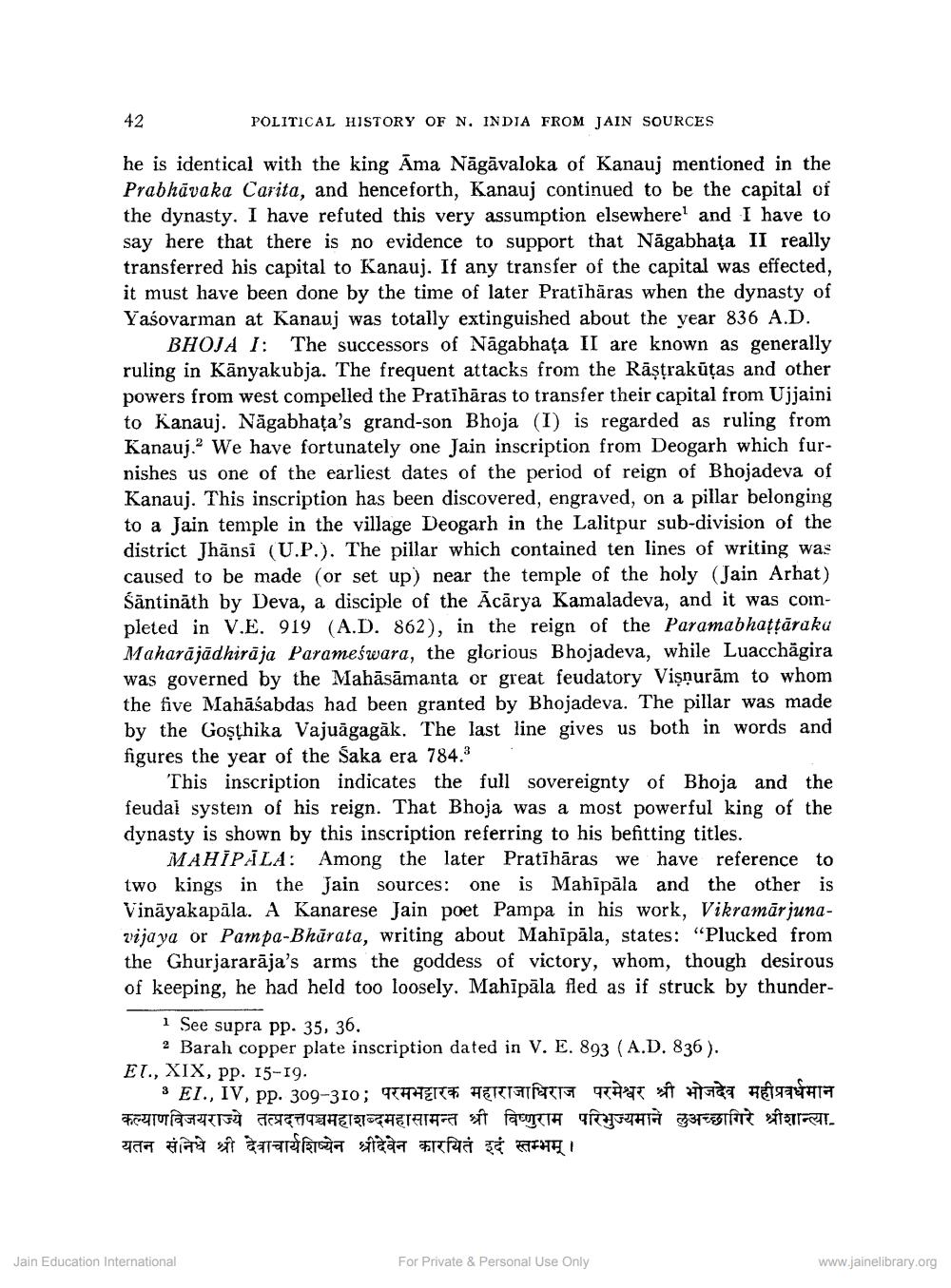________________
42
POLITICAL HISTORY OF N. INDIA FROM JAIN SOURCES
he is identical with the king Ama Nāgāvaloka of Kanauj mentioned in the Prabhāvaka Carita, and henceforth, Kanauj continued to be the capital of the dynasty. I have refuted this very assumption elsewhere and I have to say here that there is no evidence to support that Nāgabhata II really transferred his capital to Kanauj. If any transfer of the capital was effected, it must have been done by the time of later Pratīhāras when the dynasty of Yasovarman at Kanauj was totally extinguished about the year 836 A.D.
BHOJA I: The successors of Nāgabhata II are known as generally ruling in Kānyakubja. The frequent attacks from the Rāştrakūtas and other powers from west compelled the Pratīhāras to transfer their capital from Ujjaini to kanauj. Nägabhata's grand-son Bhoja (I) is regarded as ruling from Kanauj.? We have fortunately one Jain inscription from Deogarh which furnishes us one of the earliest dates of the period of reign of Bhojadeva of Kanauj. This inscription has been discovered, engraved, on a pillar belonging to a Jain temple in the village Deogarh in the Lalitpur sub-division of the district Jhānsi (U.P.). The pillar which contained ten lines of writing was caused to be made (or set up) near the temple of the holy (Jain Arhat) śāntināth by Deva, a disciple of the Ācārya Kamaladeva, and it was completed in V.E. 919 (A.D. 862), in the reign of the Paramabhațțäraku Maharājādhiräja Parameswara, the glorious Bhojadeva, while Luacchägira was governed by the Mahāsāmanta or great feudatory Vişnurām to whom the five Mahāśabdas had been granted by Bhojadeva. The pillar was made by the Goşthika Vajuāgagāk. The last line gives us both in words and figures the year of the Saka era 784.3
"This inscription indicates the full sovereignty of Bhoja and the feudal system of his reign. That Bhoja was a most powerful king of the dynasty is shown by this inscription referring to his befitting titles.
MAHİPĀLA: Among the later Pratīhāras we have reference to two kings in the Jain sources: one is Mahīpāla and the other is Vināyakapāla. A Kanarese Jain poet Pampa in his work, Vikramārjunavijaya or Pampa-Bhārata, writing about Mahīpāla, states: "Plucked from the Ghurjararāja's arms the goddess of victory, whom, though desirous of keeping, he had held too loosely. Mahīpāla fled as if struck by thunder
i See supra pp. 35, 36.
2 Barah copper plate inscription dated in V. E. 893 (A.D. 836). EI., XIX, pp. 15-19.
SEI., IV, pp. 309-310; THETTE. HETTATTET ft 5127 THT कल्याणविजयराज्ये तत्प्रदत्तपञ्चमहाशब्दमहासामन्त श्री विष्णुराम परिभुज्यमाने लुअच्छागिरे श्रीशान्त्या. यतन संनिधे श्री देवाचार्यशिष्येन श्रीदेवेन कारयितं इदं स्तम्भम् ।
Jain Education International
For Private & Personal Use Only
www.jainelibrary.org




